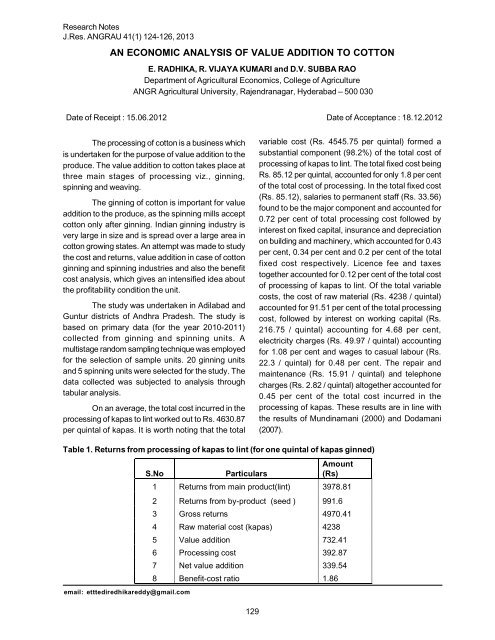The Journal of Research ANGRAU
Contents of 41(1) 2013 - acharya ng ranga agricultural university
Contents of 41(1) 2013 - acharya ng ranga agricultural university
Create successful ePaper yourself
Turn your PDF publications into a flip-book with our unique Google optimized e-Paper software.
<strong>Research</strong> Notes<br />
J.Res. <strong>ANGRAU</strong> 41(1) 124-126, 2013<br />
AN ECONOMIC ANALYSIS OF VALUE ADDITION TO COTTON<br />
E. RADHIKA, R. VIJAYA KUMARI and D.V. SUBBA RAO<br />
Department <strong>of</strong> Agricultural Economics, College <strong>of</strong> Agriculture<br />
ANGR Agricultural University, Rajendranagar, Hyderabad – 500 030<br />
Date <strong>of</strong> Receipt : 15.06.2012 Date <strong>of</strong> Acceptance : 18.12.2012<br />
<strong>The</strong> processing <strong>of</strong> cotton is a business which<br />
is undertaken for the purpose <strong>of</strong> value addition to the<br />
produce. <strong>The</strong> value addition to cotton takes place at<br />
three main stages <strong>of</strong> processing viz., ginning,<br />
spinning and weaving.<br />
<strong>The</strong> ginning <strong>of</strong> cotton is important for value<br />
addition to the produce, as the spinning mills accept<br />
cotton only after ginning. Indian ginning industry is<br />
very large in size and is spread over a large area in<br />
cotton growing states. An attempt was made to study<br />
the cost and returns, value addition in case <strong>of</strong> cotton<br />
ginning and spinning industries and also the benefit<br />
cost analysis, which gives an intensified idea about<br />
the pr<strong>of</strong>itability condition the unit.<br />
<strong>The</strong> study was undertaken in Adilabad and<br />
Guntur districts <strong>of</strong> Andhra Pradesh. <strong>The</strong> study is<br />
based on primary data (for the year 2010-2011)<br />
collected from ginning and spinning units. A<br />
multistage random sampling technique was employed<br />
for the selection <strong>of</strong> sample units. 20 ginning units<br />
and 5 spinning units were selected for the study. <strong>The</strong><br />
data collected was subjected to analysis through<br />
tabular analysis.<br />
On an average, the total cost incurred in the<br />
processing <strong>of</strong> kapas to lint worked out to Rs. 4630.87<br />
per quintal <strong>of</strong> kapas. It is worth noting that the total<br />
variable cost (Rs. 4545.75 per quintal) formed a<br />
substantial component (98.2%) <strong>of</strong> the total cost <strong>of</strong><br />
processing <strong>of</strong> kapas to lint. <strong>The</strong> total fixed cost being<br />
Rs. 85.12 per quintal, accounted for only 1.8 per cent<br />
<strong>of</strong> the total cost <strong>of</strong> processing. In the total fixed cost<br />
(Rs. 85.12), salaries to permanent staff (Rs. 33.56)<br />
found to be the major component and accounted for<br />
0.72 per cent <strong>of</strong> total processing cost followed by<br />
interest on fixed capital, insurance and depreciation<br />
on building and machinery, which accounted for 0.43<br />
per cent, 0.34 per cent and 0.2 per cent <strong>of</strong> the total<br />
fixed cost respectively. Licence fee and taxes<br />
together accounted for 0.12 per cent <strong>of</strong> the total cost<br />
<strong>of</strong> processing <strong>of</strong> kapas to lint. Of the total variable<br />
costs, the cost <strong>of</strong> raw material (Rs. 4238 / quintal)<br />
accounted for 91.51 per cent <strong>of</strong> the total processing<br />
cost, followed by interest on working capital (Rs.<br />
216.75 / quintal) accounting for 4.68 per cent,<br />
electricity charges (Rs. 49.97 / quintal) accounting<br />
for 1.08 per cent and wages to casual labour (Rs.<br />
22.3 / quintal) for 0.48 per cent. <strong>The</strong> repair and<br />
maintenance (Rs. 15.91 / quintal) and telephone<br />
charges (Rs. 2.82 / quintal) altogether accounted for<br />
0.45 per cent <strong>of</strong> the total cost incurred in the<br />
processing <strong>of</strong> kapas. <strong>The</strong>se results are in line with<br />
the results <strong>of</strong> Mundinamani (2000) and Dodamani<br />
(2007).<br />
Table 1. Returns from processing <strong>of</strong> kapas to lint (for one quintal <strong>of</strong> kapas ginned)<br />
S.No<br />
email: etttediredhikareddy@gmail.com<br />
Particulars<br />
129<br />
Amount<br />
(Rs)<br />
1 Returns from main product(lint) 3978.81<br />
2 Returns from by-product (seed ) 991.6<br />
3 Gross returns 4970.41<br />
4 Raw material cost (kapas) 4238<br />
5 Value addition 732.41<br />
6 Processing cost 392.87<br />
7 Net value addition 339.54<br />
8 Benefit-cost ratio 1.86

















